How many times a day do you speak? Even if you’re an introvert, it’s probably quite a few. You talk to your friends, raise your hand to speak in class and thank the Starbucks barista for your coffee. That’s a good amount of chatter. In the noisiness of the world we live in, it’s hard to find some peace and quiet. For one week, however, I did.
Every day for a week, I practiced silent meditation for half an hour. That’s thirty minutes of silence between me, myself and I. If you’re especially talkative, you might be wondering why anyone would choose to not say or do anything for a block of time. In fact, the concept of meditation raises a few questions. Here’s the what, why and how of my experience with silent meditation.
What is meditation?
What do you think of when you hear someone mention meditation? If you don’t have experience with it, the image of meditation that comes to mind is probably someone sitting cross-legged, eyes closed and hands pressed together. This is known as the “lotus position,” and it’s just one pose from the diverse discipline of meditation.
Meditation is practiced by people of many different religions, including Buddhism, Christianity and Islam. It doesn’t have to be a solely religious experience, though. Meditation is a practice that encourages mindfulness in whatever form that takes for you personally. There are some aspects of meditation that are universal. Meditation typically involves structured breathing, focused thoughts and a block of uninterrupted time.
Guided meditation involves a person (either on a recording or in the flesh) walking you through the steps of the meditative exercise. They will typically guide your breathing and make statements to direct your thoughts. With unguided meditation, you direct yourself.
Both guided and unguided meditation can involve the chanting of a mantra. A mantra is basically a word or idea you want to concentrate on. It can be based on religious traditions but can incorporate whatever the target of your meditation is. So, yes, if you’re really worried about that chem exam, you can make passing it part of your mantra.
A mantra isn’t necessary for meditation, though. For my week of daily practice, I meditated silently.
Why did I meditate?
I’ve had experience with meditation before. It was typically guided and in the environment of the Christian church. I’ve even written meditations for use by other people. However, silent meditation was one area where I’d never really dabbled.
I ran headfirst into this semester. If I wasn’t rushing to class, I was running off to a meeting. If I wasn’t running off to a meeting, I was hurrying to meet the students I tutor. A couple weeks into the month of January, late nights churning out papers had already become routine. I even had laundry penciled into my schedule. After a couple stressful weeks of dry shampoo, coffee for lunch and a parking ticket because I straight-up forgot to move my car, I knew I had to do something.
Meditation has been helpful to me in the past. When I’ve been anxious or restless, it’s given me feelings of peace. When I’m chasing a new goal that I’m worried I might not reach, meditation has helped me manifest positive thoughts. For this particular time, I wanted to use meditation as a means of centering my thoughts. I knew I had to get myself organized and on the right track. That starts with my attitude. If I could use meditation to focus my thoughts on getting my life together – I mean, centering my life –, then actually doing it might be easier.
My life was and still is busy, and I associate busy things with loud things. That’s why I chose silent meditation. I wanted to intentionally create time in my hectic, noisy day for complete and total quiet. If I could calm my thoughts down, maybe I could calm my life down.
How did meditation affect me?
The first challenge I faced in my decision to meditate every day was making time for it. Because I was basically running nonstop every day, I had the option of either meditating for thirty minutes before I went to bed or waking up thirty minutes early to do it. I chose half an hour for meditation because it would provide me enough time to structure my breathing, center my thoughts and transition out of the meditative state without completely wrecking my schedule.
I chose to meditate in the morning. Even though I’m a night owl, I know that if I try to sit in silence at the end of the day, I’ll fall asleep. There’s no doubt about it. However, if you decide to try meditation and do end up catching some Z’s instead, it’s okay! Author Mike McHargue says that if you fall asleep while meditating, it’s because you need the rest, so don’t “judge your body” for passing out.
So, I set my alarm for thirty minutes earlier than normal every day that week. Then, after I got ready for the day, I sat cross-legged on my bed because that’s what’s comfortable for me. I closed my eyes and began to structure my breathing. I do this by breathing in slowly through the nose while thinking “inhale” and breathing out slowly through the mouth while thinking “exhale.” There’s one thing about silent meditation, though: It’s hard. Thinking about nothing is virtually impossible, and it’s not the point of meditation anyway.
Instead, as each thought came to me, I contemplated it instead of bouncing on to the next one. If I had a thought about something I needed to do, like studying for a quiz or completing an assignment, I thought first about why it was important to me that I complete that task. Then, I asked myself to create a plan to realistically accomplish that goal.
On the first day, I had a lot of trouble. I would start thinking about what I was going to have for dinner that night or what show I should start on Hulu. The silence seemed to last forever, too. I’m going to be honest. I snuck a couple of peeks at the timer on my phone that was set to vibrate after my thirty minutes were up.
Over the course of the week, though, I got better at contemplating my thoughts. The thirty minutes didn’t feel so long by the last day. Best of all, when I opened my eyes, I had a realistic plan for how to deal with everything I had to do that day. My schedule didn’t seem so busy or daunting. I felt confident. I was ready to tackle whatever came my way.
Now that I feel more in control of my life, I don’t plan on silently meditating every day. However, I’ll probably return to the practice in the future whenever my world starts feeling crazy. If you’re even a little bit interested in meditation, I strongly recommend you look into it. There are all kinds of fifteen-minute guided meditations on YouTube and some on iTunes, too. Thanks to my week of silent meditation, I have my life at least a little more together.


